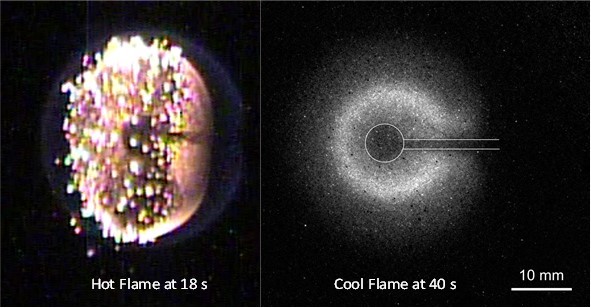
|
 |
Image: Hot flames (left) give way to cool flames (right). |
|
A discovery has been made in Earth's orbit – steady spherical cool diffusion flames. Measurements in these flames could help improve the engines of the future.
Most experts expected it would be easy to obtain cool diffusion flames burning gases in microgravity, but researchers have found this is not the case. Between January and June, 2021, they burned over 150 hot diffusion flames aboard the International Space Station (ISS), some for as long as 3 minutes, yet none transitioned from hot to cool burning after extinguishing.
On June 23, with a slight change in conditions, Minhyeng Kim -- a University of Maryland (UMD) Fire Protection Engineering (FPE) Graduate Student -- noticed something unusual in three of the tests: after the hot flames extinguished and disappeared in the camera view, heat was still being produced. The fuel was n-butane diluted with nitrogen and the oxidizer was 40% oxygen in nitrogen. The pressure was 2 atm.
The flames were so dim that even the most sensitive camera available for the tests initially revealed nothing.
Then, Kendyl Waddell -- a mechanical engineering student, advised by FPE Professor, Peter Sunderland -- enhanced the video feed to reveal astounding behavior. After the hot flame extinguished and all reactions ceased, residual heat in the porous burner re-ignited the flowing fuel as a steady spherical cool diffusion flame.
The experiments were performed as part of the Cool Flames Investigation with Gases (CFI-G) project -- led by Peter Sunderland (UMD FPE), Richard Axelbaum (Washington University) and Forman Williams (University of California, San Diego), and supported by the NSF, NASA and CASIS.
"These flames have several favorable characteristics that have never before been combined," Sunderland said. "They have known, controlled and steady flow rates. They are self-sustaining without heated reactants or exotic oxidizers. Their reaction zones are thick (on the order of 6 mm), which facilitates measurements and simulations. The fuel is the light and gaseous n-butane, like the contents of most cigarette lighters."
Cool flames burn at 600 – 1000 K, far cooler than the 1100 – 2200 K of typical hot flames. Cool diffusion flames, discovered in 2012 using liquid fuel droplets (also aboard the ISS), were recently created in normal gravity using heated air and usually with liquid fuels and exotic oxidizers.
This phenomenon has already generated tremendous interest in the combustion researcher community. The goal is to generate a comprehensive understanding of cool flame chemistry that will enable cleaner and more efficient engines and burners, as well as improved fire safety.
July 7, 2021
|

